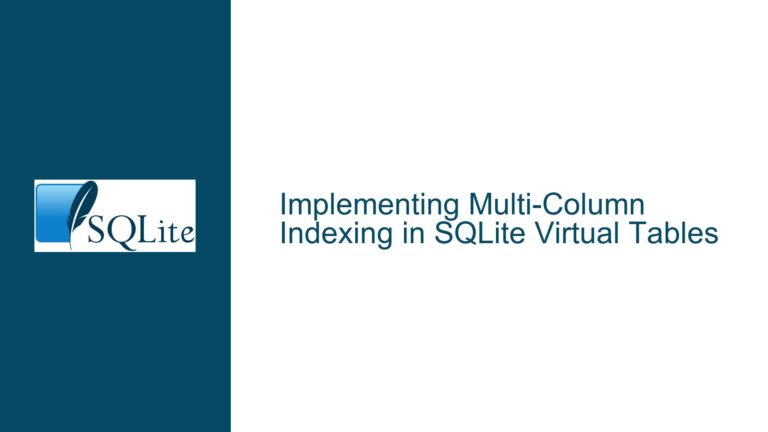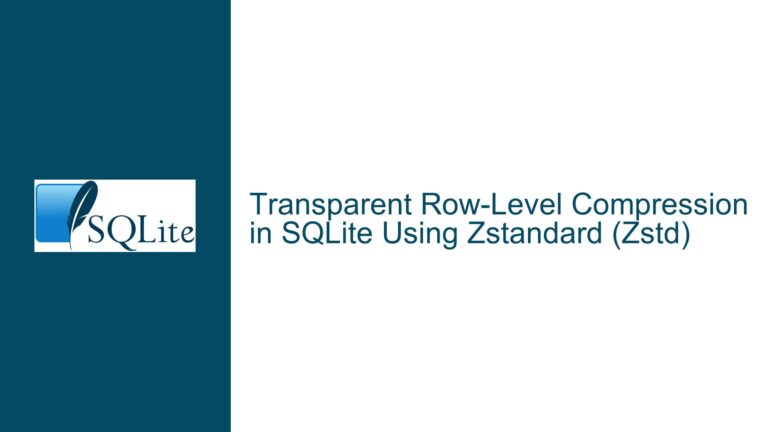SQLite Memory Allocation Limits with Custom Pagecache and Heap
Metadata Overhead and Allocation Strategies in SQLite Memory Databases
SQLite’s memory management involves multiple layers of abstraction, including the heap, page cache, and metadata storage. When configuring a memory database with custom heap and page cache sizes, the observed memory usage often diverges from naive calculations due to hidden overheads and allocation strategies. For example, a user attempting to insert ~478,000 rows into a WITHOUT ROWID table with a 16MB heap and 16MB page cache encountered an out-of-memory (NOMEM) error despite estimating that raw data storage should require only ~3.6MB. This discrepancy arises from metadata storage requirements, page header overheads, and SQLite’s internal allocation patterns. Each page in the page cache includes metadata such as the page number, dirty flag, and pointers to adjacent pages. These headers consume additional memory beyond the raw data payload. The exact overhead depends on compile-time settings and runtime configurations, which can be measured using sqlite3_config(SQLITE_CONFIG_PCACHE_HDRSZ). For instance, a 272-byte header per 4096-byte page adds ~6% overhead, but this scales non-linearly as the number of pages increases. Furthermore, SQLite’s memory allocator rounds small allocations to the next power of two (e.g., 8 bytes → 32 bytes), amplifying fragmentation. These factors combine to reduce the effective capacity of the heap and page cache, leading to premature resource exhaustion.
Page Cache and Heap Interaction During Bulk Insert Operations
The relationship between the page cache and heap is critical for understanding memory constraints. SQLite uses the page cache to buffer changes before writing them to the database file (or in-memory heap). When inserting rows, SQLite first fills the page cache with modified pages. Once the page cache is full, it flushes pages to the heap, freeing space for new operations. However, if both the page cache and heap are configured with identical sizes (e.g., 16MB each), the total usable memory effectively doubles during this process. The page cache acts as a temporary buffer, allowing SQLite to defer heap allocations until necessary. If the heap lacks sufficient space to absorb flushed pages, the step() function returns NOMEM even if the page cache still has capacity. This explains why doubling the page cache or heap size independently increases the number of successful insertions: a larger page cache delays the need for heap flushes, while a larger heap accommodates more flushed pages. However, the interaction is not purely additive. Metadata overhead and allocation rounding reduce the effective capacity of both pools. For example, a 16MB page cache with 4096-byte pages and 272-byte headers can store only ~3,800 pages (16MB / (4096 + 272) ≈ 3,800), not 4,096 pages. Similarly, a heap configured with an 8-byte minimum allocation size may waste memory due to alignment constraints, further reducing usable space.
Diagnosing and Resolving Memory Constraints in SQLite Configurations
To address NOMEM errors in memory-constrained environments, follow these steps:
- Measure Metadata Overhead: Use
sqlite3_config(SQLITE_CONFIG_PCACHE_HDRSZ)to determine the per-page header size. Multiply this by the number of pages in the cache to calculate total metadata overhead. Adjust the page cache size to account for this overhead. - Optimize Allocation Sizes: Configure the heap’s minimum allocation size to match common SQLite object sizes (e.g., 32 or 64 bytes) to reduce fragmentation. Avoid overly granular sizes (e.g., 8 bytes), which force excessive rounding.
- Balance Page Cache and Heap Sizes: Allocate more memory to the page cache if inserts fail early, as this delays heap flushes. Conversely, prioritize the heap if flushes frequently exhaust memory.
- Monitor Flush Behavior: Use
sqlite3_db_status(SQLITE_DBSTATUS_CACHE_USED)to track page cache utilization during inserts. Sudden drops indicate flushes to the heap, which may coincide with NOMEM errors if the heap is undersized. - Adjust Schema Design: For
WITHOUT ROWIDtables, ensure the primary key size is minimal. Larger keys increase per-page metadata (e.g., b-tree node pointers), reducing storage efficiency. - Test Incremental Configuration Changes: Gradually increase the page cache and heap sizes while monitoring insertion limits. Empirical testing reveals non-linear improvements due to overhead thresholds.
For example, doubling the page cache from 16MB to 32MB allows ~7,600 pages (accounting for headers), deferring heap flushes and increasing insertions. Pairing this with a 32MB heap ensures flushed pages do not exhaust heap space. If metadata overhead dominates, consider reducing the page size (e.g., 1024 bytes) to minimize per-page waste, though smaller pages increase b-tree depth and query latency. Ultimately, SQLite’s memory behavior is highly contextual, requiring careful tuning of both allocator parameters and schema design to match workload demands.






